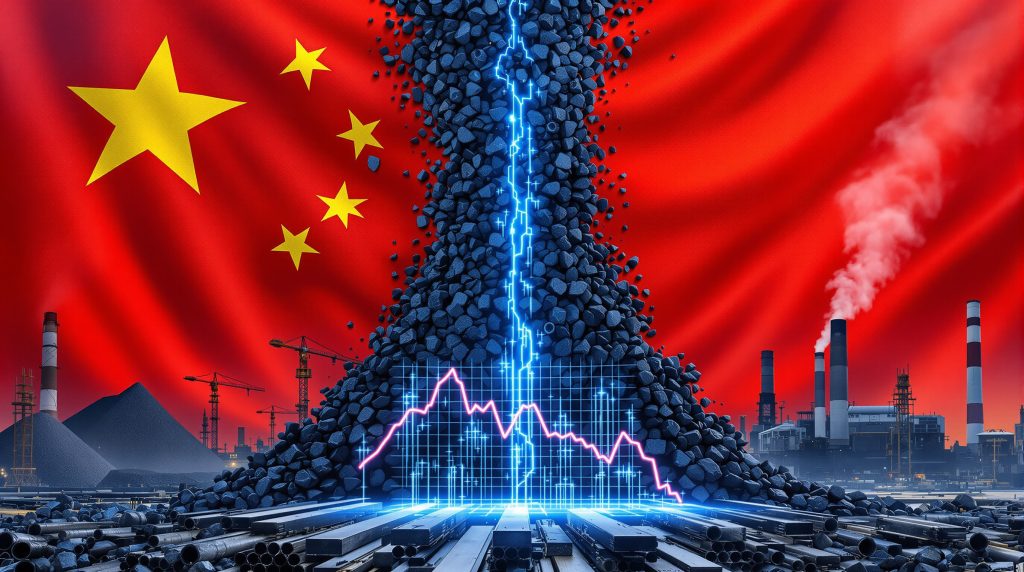How Are China's Steel Margins Affecting Iron Ore Prices?
Iron ore futures have fallen to their lowest levels in a week, with the January contract on China's Dalian Commodity Exchange dropping 2.67% to 766 yuan ($107.09) per metric ton—the lowest since August 20. Similarly, the benchmark October iron ore contract on the Singapore Exchange declined by 2.05% to $101.35 per ton, reaching its weakest point since August 25.
This price deterioration stems directly from narrowing steel production margins, which have diminished steelmakers' appetite for raw materials. As profit margins contract, steel producers are becoming increasingly cost-conscious, reducing procurement volumes and putting downward pressure on iron ore price trends.
Market analysts at Hongyuan Futures note that "narrower steel margins, coupled with expectations of lower hot metal output, have put pressure on ore prices," reflecting the direct connection between steel profitability and iron ore demand.
Key Factors Behind Shrinking Steel Margins:
- Production costs remain elevated while finished steel prices struggle
- Oversupply in China's domestic steel market creating price competition
- Reduced construction activity limiting steel demand growth
- Energy and environmental compliance costs adding pressure to margins
What's Driving China's Weakening Steel Demand?
Persistent Property Sector Challenges
The ongoing struggles in China's property sector continue to cast a long shadow over steel demand. Real estate development, historically a major consumer of China's steel output, faces structural headwinds that show little sign of abating in 2025.
According to industry data, housing construction has traditionally absorbed approximately one-third of China's steel production. However, current market conditions indicate this consumption pattern is shifting dramatically downward, representing a fundamental change rather than a cyclical downturn.
Industry analysts from major financial institutions predict this structural shift could potentially reduce steel's share in housing construction by up to 40% over the coming years, suggesting prolonged pressure on iron ore price decline.
| Property Sector Indicators | Current Status | Impact on Steel Demand |
|---|---|---|
| New construction starts | Declining | Significant negative |
| Property developer funding | Constrained | Moderate negative |
| Existing inventory levels | Elevated | Moderate negative |
| Government support measures | Limited | Slight positive |
Manufacturing Sector Weakness
China's manufacturing activity has contracted for five consecutive months through August 2025, according to official surveys. This persistent weakness signals broader economic challenges beyond just the property sector.
The manufacturing Purchasing Managers' Index (PMI) remaining below the 50-point threshold separating growth from contraction indicates domestic demand remains sluggish across multiple industrial segments. A Singapore-based trader observed that "it's the beginning of a poor week, with steel inventories piling up and weak manufacturing data."
This widespread softness further erodes the demand foundation for steel products and, by extension, iron ore.
How Are Production Restrictions Impacting Iron Ore Demand?
Military Parade Production Curbs
An immediate factor affecting iron ore prices is the temporary production restrictions implemented ahead of a military parade scheduled for September 3, 2025, commemorating the end of World War Two. Steel producers in Tangshan and other northern Chinese industrial hubs have been directed to curtail production to improve air quality for the event.
Industry experts expect hot metal output—a key gauge of iron ore demand—to "fall sharply" in the coming days as steelmakers comply with these restrictions. While temporary, such interventions contribute to market uncertainty and price volatility.
Long-Term Production Control Policies
Beyond temporary restrictions, China's longer-term steel production control policies continue to shape market dynamics. The government's commitment to:
- Limiting total steel output
- Reducing industry carbon emissions
- Addressing overcapacity issues
- Promoting industry consolidation
These policies create a structural ceiling for iron ore demand growth, even if economic activity were to accelerate in other sectors.
What Do Current Inventory Levels Tell Us About Market Conditions?
Rising Steel Inventories
According to market observers, steel inventories are "piling up" across China's industrial centers, signaling a fundamental mismatch between production and consumption rates.
When finished steel products accumulate in warehouses, it indicates that production exceeds actual market demand. This imbalance eventually forces producers to reduce output, directly impacting iron ore consumption.
Iron Ore Port Stockpiles
Iron ore inventories at Chinese ports have been trending higher in recent months, reflecting weakened consumption rates. These elevated stockpiles provide steelmakers with buffer supplies, reducing urgency in procurement and further pressuring prices.
| Inventory Metric | Current Level | Comparison to Historical Average | Market Signal |
|---|---|---|---|
| Steel product inventories | Increasing | Above seasonal norms | Bearish |
| Iron ore port stocks | Elevated | Above five-year average | Bearish |
| Steel mill raw material inventories | Sufficient | Above operational requirements | Bearish |
How Are Other Steelmaking Ingredients Performing?
The weakness in iron ore markets extends to other steelmaking raw materials. Coking coal and coke prices have also declined significantly, hitting their lowest levels in four weeks with drops of 3.29% and 3.54%, respectively.
This synchronized decline across the steelmaking raw material complex reinforces the view that the underlying issue is demand-side weakness rather than supply-side disruptions. When all input materials move in tandem, it typically signals a fundamental shift in end-user demand.
Factors Affecting Coking Coal and Coke Markets:
- Reduced blast furnace utilization rates limiting consumption
- Sufficient inventory levels at steel mills
- Import availability from various sources
- Seasonal demand patterns
What Are The Technical Indicators Showing For Iron Ore Prices?
Price Support and Resistance Levels
Iron ore prices are approaching important technical support levels that could determine their near-term trajectory. The psychological $100 per ton threshold represents a significant barrier, with market behavior around this level potentially setting the tone for coming weeks.
With Singapore Exchange iron ore futures trading at $101.35 per ton as of early September, market participants are closely watching whether prices will stabilize above the $100 mark or break below this key psychological level.
Trading Patterns and Volume Analysis
Recent trading sessions have shown increased selling pressure with higher-than-average volumes on down days, suggesting strong bearish sentiment. The market appears to be establishing a new trading range below previous support levels, indicating a potential recalibration of price expectations.
Technical analysts note that the speed of the recent decline, coupled with increasing trading volumes, points to a market that may still be searching for its equilibrium point.
What's The Outlook For China's Steel Production?
Blast Furnace Utilization Rates
Blast furnace utilization rates serve as a key indicator of steel production activity—and by extension iron ore demand. Industry monitoring services report these rates have declined steadily over recent months, reflecting both regulatory restrictions and economic considerations.
The reduced operating rate translates directly to lower iron ore consumption, as blast furnaces represent the primary consumption point for iron ore in the steelmaking process.
Production Forecasts
Market analysts project that China's steel production could experience a modest decline in 2025 compared to the previous year. This reduction, while potentially small in percentage terms, represents a significant volume of steel and corresponding iron ore consumption given China's massive production base.
Industry forecasters cite the combination of property sector weakness, manufacturing contraction, and production restrictions as key factors likely to constrain steel output through the remainder of 2025.
How Are Global Iron Ore Suppliers Responding?
Major Miners' Production Strategies
The world's largest iron ore producers are closely monitoring China's demand signals and adjusting their strategies accordingly. While none have announced major production cuts, there are indications of more selective capital allocation and cautious expansion plans.
Major producers have historically been reluctant to reduce output substantially during price downturns, preferring instead to focus on cost reduction and operational efficiency to maintain market share.
Price Differentiation by Grade
The current market environment has widened the price gap between high-grade and lower-grade iron ore products. Steel producers, facing margin pressure, increasingly favor higher-grade materials that improve production efficiency and reduce emissions—even at premium prices.
This quality-based price differentiation benefits producers of premium ore while putting additional pressure on miners of lower-grade material. For a more comprehensive understanding, analysts are closely examining iron ore miners insight to gauge how the industry is adapting to these market shifts.
What Are The Implications For Global Iron Ore Markets?
Price Forecast Revisions
Market analysts have begun revising their iron ore price forecast downward for the remainder of 2025 and into 2026. Current projections suggest prices may stabilize in the $90-100 per ton range in the near term, with potential further softening if Chinese demand continues to weaken.
The extent of any price recovery will largely depend on how effectively China manages its economic transition and whether stimulus measures can offset property sector weakness.
Supply-Demand Balance Shifts
The global iron ore market appears to be transitioning from a relatively balanced position to a potential surplus situation. While major disruptions could still create temporary tightness, the overall trend points toward sufficient supply relative to demand in the medium term.
New supply coming online from expansion projects, combined with constrained demand growth, suggests a market that may remain well-supplied through 2026.
How Might Government Policies Influence Future Trends?
China's Economic Stimulus Measures
The extent and nature of China's economic support policies will significantly influence iron ore demand. Current stimulus measures have been targeted rather than broad-based, with limited direct support for property developers or heavy industry.
Any shift toward more aggressive infrastructure investment or property sector support could provide a counterbalance to the current downward pressure on steel demand and iron ore prices.
Environmental Regulations
China's ongoing commitment to environmental goals continues to shape its steel industry. Policies promoting electric arc furnace (EAF) production over traditional blast furnaces could structurally reduce iron ore demand over time, as EAFs primarily use scrap steel rather than iron ore.
Environmental compliance requirements may also accelerate the consolidation of China's steel industry, potentially leading to more efficient resource allocation but also reducing overall iron ore consumption. This transition is part of BHP's strategic pivot as the mining giant adjusts to changing market conditions.
FAQs About Iron Ore Price Trends
Why are iron ore prices falling despite global economic growth?
Iron ore prices are primarily influenced by China's steel sector, which accounts for roughly 70% of global seaborne iron ore demand. Even as other economies grow, China's structural shift away from property-led growth and industrial overcapacity issues create an outsized impact on iron ore markets.
How do seasonal factors affect iron ore prices?
Seasonal patterns typically include stronger demand during spring construction season (March-May) and autumn (September-October), with slower activity during winter months and summer heat restrictions. However, in 2025, these seasonal patterns have been overshadowed by broader structural issues.
What role does China's steel export market play in iron ore demand?
While China's steel exports have increased in 2025, providing some offset to domestic demand weakness, export volumes alone cannot compensate for the reduction in domestic consumption. Additionally, international trade tensions and protectionist measures limit the potential for export-led growth to fully counterbalance domestic weakness.
How might iron ore prices respond to potential supply disruptions?
Supply disruptions from major producers in Australia or Brazil could temporarily tighten the market and support prices. However, the current demand weakness means that even moderate supply issues might have a more muted price impact than in previous years when the market was tighter.
Ready to Spot the Next Major Mineral Discovery?
Don't miss out on significant market opportunities like the ones highlighted in this article – Discovery Alert's proprietary Discovery IQ model delivers instant notifications on ASX mineral discoveries, turning complex data into actionable insights. Explore why major discoveries can lead to substantial returns by visiting Discovery Alert's dedicated discoveries page.




